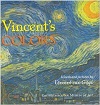|
Vincent's Colors

Last updated Monday, August 3, 2015
Author: Vincent Van Gogh
Date of Publication: 2005
ISBN: 0811850994
Grade Level: 2nd (GLCs: Click here for grade level guidelines.)
Date(s) Used: Aug. 2015
Synopsis:
Vincent van Gogh is one of the world's most famous artists. Throughout his life, he wrote to his younger brother, Theo, about his colorful, dynamic paintings. This book pairs the artist's paintings with his own words.
Van Gogh's descriptions, arranged as a simple rhyme, introduce young readers to all the colors of the rainbowand beyond. The descriptive words combine with spectacular reproductions of many of the artist's most beloved and important works to create a perfect art book for young and old alike.
| Note to readers: |
| • |
Facts about Vincent Van Gogh (30 March 1853 - 29 July 1890):
|
| • |
In just over a decade, he produced more than 2,100 artworks, including 860 oil paintings and more than 1,300 watercolors, drawings, sketches and prints.
|
| • |
Before becoming an artist, he planned to become a minister. He failed the theology school exam and a missionary program.
|
| • |
One of his paintings sold in 1987 for $82 million dollars and in 1990 another sold for $150.1 million dollars!
|
| Discussion topics for before reading: |
| • |
Do you know who Vincent Van Gogh is? (A famous artist who lived more than a hundred years ago.)
|
| • |
Have you ever been to a museum? What was it like?
|
| • |
Have you ever painted a picture?
Vocabulary
|
| • |
cypress - a tall and narrow evergreen tree
|
| • |
iris - a plant with long pointed leaves and large blue or yellow flowers
|
| • |
gloomy - partially or totally dark; causing feelings of sadness
|
| • |
sparkling - shining with or reflecting bright points of light
|
| Discussion topics for during/after reading: |
| • |
Which one of Vincent's paintings do you like the most?
|
| • |
What type of brush strokes can you see in his paintings? This style of painting is called Impressionism.
|
| • |
Why do you think Van Gogh's paintings are so popular?
|
| Craft ideas: |
| • |
Draw one of Van Gogh's famous works using short and circular strokes with similar colors to create texture.
|
| • |
Color one of the provided Van Gogh coloring pages.
|
| • |
Draw a self-portrait.
|
*Note: These craft ideas are just suggestions.
You can use them, but you don't have to use them.
You can expand upon them, or add your own twist.
Remember, though, that the focus of your time should
not be on the development and execution of a craft;
the focus should be on the read-aloud and the
enjoyment of the book!
|
